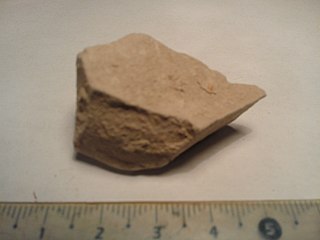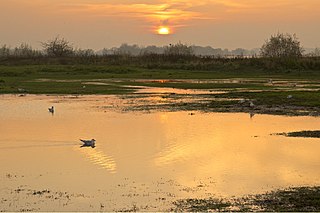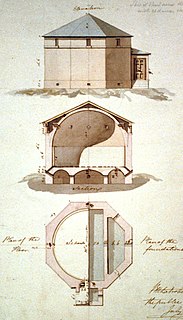This article needs additional citations for verification .(January 2017) (Learn how and when to remove this template message) |
Coordinates: 51°50′55″N5°52′11″E / 51.84861°N 5.86972°E

A geographic coordinate system is a coordinate system that enables every location on Earth to be specified by a set of numbers, letters or symbols. The coordinates are often chosen such that one of the numbers represents a vertical position and two or three of the numbers represent a horizontal position; alternatively, a geographic position may be expressed in a combined three-dimensional Cartesian vector. A common choice of coordinates is latitude, longitude and elevation. To specify a location on a plane requires a map projection.


The Stratemakerstoren is an early 16th-century bastion on the Waalkade in the Dutch town Nijmegen. It is a rijksmonument (national heritage site) and since 1995, it housed a museum. This was closed in April 2015, for major reconstruction.

A bastion or bulwark is a structure projecting outward from the curtain wall of a fortification, most commonly angular in shape and positioned at the corners. The fully developed bastion consists of two faces and two flanks with fire from the flanks being able to protect the curtain wall and also the adjacent bastions. It is one element in the style of fortification dominant from the mid 16th to mid 19th centuries. Bastion fortifications offered a greater degree of passive resistance and more scope for ranged defense in the age of gunpowder artillery compared with the medieval fortifications they replaced.

The Netherlands is a country located mainly in Northwestern Europe. The European portion of the Netherlands consists of twelve separate provinces that border Germany to the east, Belgium to the south, and the North Sea to the northwest, with maritime borders in the North Sea with Belgium, Germany and the United Kingdom. Including three island territories in the Caribbean Sea—Bonaire, Sint Eustatius and Saba— it forms a constituent country of the Kingdom of the Netherlands. The official language is Dutch, but a secondary official language in the province of Friesland is West Frisian.

Nijmegen is a city in the Dutch province of Gelderland, on the Waal river close to the German border.
The Stratemakerstoren is located on the edge of the river Waal, at the foot of the Valkhof at Nijmegen. This bastion was a part of the fortifications of Nijmegen, built in or before 1526. The current name, which means "Road Workers Tower", was already in use in 1569 - the reason for this name is still not exactly known.

The Waal is the main distributary branch of the river Rhine flowing approximately 80 km (50 mi) through the Netherlands. It is the major waterway connecting the port of Rotterdam to Germany. Before it reaches Rotterdam, it joins with the Afgedamde Maas near Woudrichem to form the Boven Merwede. Along its length, Nijmegen, Tiel, Zaltbommel and Gorinchem are towns of importance with direct access to the river.

The Valkhof at Nijmegen is an oil painting by Dutch artist Aelbert Cuyp, likely painted between 1652 and 1654, during the Dutch Golden Age. It is currently part of the permanent collection in the Indianapolis Museum of Art.
The Stratemakerstoren was constructed to protect the adjacent gate, the Veerpoort. The tower often figures on old paintings and prints, where it is seen on the riverbank, at the foot of the Valkhof castle, for example in the painting called the Valkhof at Nijmegen.
Due to technical innovations in warfare, by the end of the 18th century, the round bastion had lost its importance as a defensive stronghold. A rise in the water level of the river Waal also meant that the tower was partly submerged. In 1789, a local carpenter, J. ten Boven, was given permission to build houses on the site of the bastion. He didn't demolish the tower completely, but just built the houses on top of the bastion. In 1987 these houses were demolished, and to almost every one's surprise the tower re-emerged.
From 1995 until 2015, the building was hidden behind a grey wall (to protect the porous marlstones and bricks against the weather), and housed a museum. In April 2015, the museum was closed for major reconstruction and restoration of the building. Plan is to re-open in 2016 as De Bastei, [1] a centre for nature and cultural history.

Marl or marlstone is a calcium carbonate or lime-rich mud or mudstone which contains variable amounts of clays and silt. The dominant carbonate mineral in most marls is calcite, but other carbonate minerals such as aragonite, dolomite, and siderite may be present. Marl was originally an old term loosely applied to a variety of materials, most of which occur as loose, earthy deposits consisting chiefly of an intimate mixture of clay and calcium carbonate, formed under freshwater conditions; specifically an earthy substance containing 35–65% clay and 65–35% carbonate. It also describes a habit of coralline red alga. The term is today often used to describe indurated marine deposits and lacustrine (lake) sediments which more accurately should be named 'marlstone'. Marlstone is an indurated rock of about the same composition as marl, more correctly called an earthy or impure argillaceous limestone. It has a blocky subconchoidal fracture, and is less fissile than shale. The term 'marl' is widely used in English-language geology, while the terms Mergel and Seekreide are used in European references.

A museum is an institution that cares for (conserves) a collection of artifacts and other objects of artistic, cultural, historical, or scientific importance. Many public museums make these items available for public viewing through exhibits that may be permanent or temporary. The largest museums are located in major cities throughout the world, while thousands of local museums exist in smaller cities, towns and rural areas. Museums have varying aims, ranging from serving researchers and specialists to serving the general public. The goal of serving researchers is increasingly shifting to serving the general public.
















